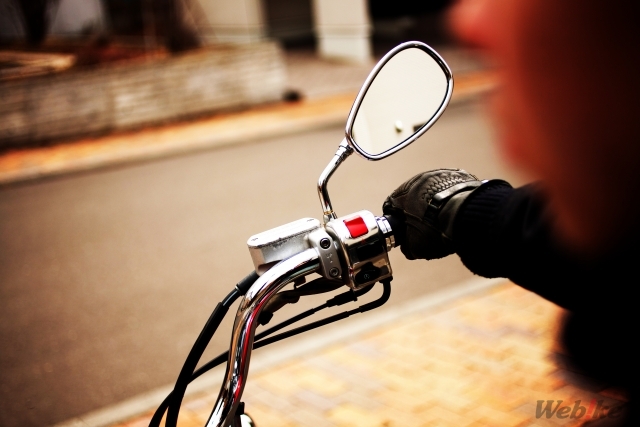[Webike News Chief Editor: Kenny Sagawa]
Hot days continue. Motorcycle clothes tend to be heavy for safety even in summer. Please prevent getting heatstroke and take care of your health. I hope you have a nice summer vacation.
On the other day, I was asked about how to use the brake from a participant of a riding school. It won't be surprised that beginners do not know a lot of operations that experienced riders always do involuntarily. Here are some advice from me. I hope you will find something helpful.
Characteristics of Motorcycle Brakes
As you may know, a motorcycle has the rear brake and front brake. A car has only one brake and the brake pedal is operated with a foot; in most motorcycles, the front brake is operated with the brake lever and the rear is with the brake pedal.
The rear and front brakes respectively have its own characteristics. It is important to use the both well or use them separately.
The front brake has strong braking force and could play a key role in the main brake. Especially recent disc brakes are so strong that sufficient braking force is gained even with only one finger.
On the other day, I was asked about how to use the brake from a participant of a riding school. It won't be surprised that beginners do not know a lot of operations that experienced riders always do involuntarily. Here are some advice from me. I hope you will find something helpful.
There are various patterns of braking. I could say there are thousands of ways depending on situations. Now, I would like to explain several patterns.
[Stopping at Traffic Light] Target Braking
For most riders, the most frequent pattern is braking when you stop at a traffic light. It is technically called "target braking," which requires skill to stop properly at a target place.
In this case, you should first use the rear brake in a moment to hold a steady posture, and then squeeze the front brake lever gradually slowly. If you use only the front brake firmly, the vehicle leans forward and loses the balance; conversely, using only the rear brake doesn't produce sufficient braking force, and if you hasten to use the rear brake too strongly, it is dangerous when wheel lock may occur. It is important to use both the rear and front brakes with a good balance.
The best way is: releasing the front brake just before a stop to prevent an abrupt stop; then stopping with only the rear brake while putting your left leg on the ground.
[Avoiding Danger] Emergency Braking
I would like to avoid a harsh brake as much as possible, but there may be a case that you have no choice but to make a hard stop in order to avert a dangerous situation. For example, when a bicycle suddenly jumps out of a side street in front of you, you need to make a stop with full might. In case of so-called "emergency braking," speed reduction and stoppage in as short a distance as possible is necessary.
In such a case, while you "slowly" use both the rear and front brakes almost simultaneously (ideally use the rear a bit faster), you squeeze the brake lever "firmly" with recognizing a feeling that the front fork goes down and the front tire is pushed to the road surface.
The front brake plays a main role in "emergency braking." It is best to continue braking until a complete stop with remaining in a last minute situation that the front tire is about to get locked.
It is extremely difficult to do these operation with a calm mind in an emergency. In order to gain skill for "emergency braking," repeating regular training is essential so that your body can automatically react.
For models equipped with ABS, in most cases, a stop with making ABS work is eventually safe and results in a short braking distance. ABS is not for shortening a braking distance theoretically; however, sensitive operations in a state of panic are difficult in real life.
[Before Corner] Speed Control
Speed control is needed in accordance with a curve before a intersection in a city or before a corner in winding roads. What is required here is accurate "speed control."
"Constantly braking long" is important. Contrary to the sudden braking, this is an image that you spend much time and use a long distance to reduce the speed gently. While you constantly use the rear brake and hold your motorcycle steady, you control delicate speed with the front brake.
If the speed is too faster before a corner, you should squeeze the front brake slightly firmly; if the speed is slow enough, then you may release the front brake along the way. Delicate front brake operations are a key factor.
Many riders mistakenly understand that they should use the brakes like sudden brakes before a corner. This is much seen among those who prefer to use the strong brakes all at once without using the brakes until the last moment before a corner. Such braking tends to cause so-called "abrupt brake" and loss of balance of motorcycle, or too much speed reduction, leading to increase of only stress because it is difficult to find a rhythm.
Safe and Comfortable Motorcycle Life with Awareness of Braking
What is important is not to do dangerous operation. Getting a cold sweat or getting nervous with braking means that you already put your foot in a dangerous area.
There are various patterns of braking as I explained and it is important to use brakes depending on a situation. Though braking is an involuntary operation, I hope you understand that it in fact contains high skill.
By becoming a little aware of braking, you will enjoy a safer and more comfortable motorcycle life. I would absolutely like you to try this out.



